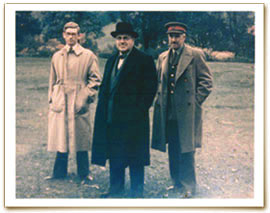
Back جون تيلتمان ARZ John Tiltman German John Tiltman Spanish جان هسل تیلتمن FA John Tiltman French John Tiltman Italian
John Hessell Tiltman | |
|---|---|
 British cryptanalysts Harry Hinsley, Sir Edward Travis, and John Tiltman in Washington D.C., November 1945 | |
| Nickname(s) | "The Brig" |
| Born | 25 May 1894 London, England |
| Died | 10 August 1982 (aged 88) Hawaii, United States |
| Allegiance | United Kingdom |
| Service | British Army |
| Years of service | 1914–1946 |
| Rank | Brigadier |
| Service number | 11225 |
| Unit | King's Own Scottish Borderers |
| Battles / wars | World War I World War II |
| Awards | Military Cross (1917)[1] OBE (1930)[1] CBE (1944)[2] CMG (1954)[3] Legion of Merit (1946)[4] |
| Spouse(s) |
Tempe Robinson (m. 1926) |
| Children | Tempe Anne Denzer |
Brigadier John Hessell Tiltman, CMG, CBE, MC (25 May 1894 – 10 August 1982) was a British Army officer who worked in intelligence, often at or with the Government Code and Cypher School (GC&CS) starting in the 1920s. His intelligence work was largely connected with cryptography, and he showed exceptional skill at cryptanalysis. His work in association with Bill Tutte on the cryptanalysis of the Lorenz cipher, the German teleprinter cipher, called "Tunny" (for tunafish) at Bletchley Park, led to breakthroughs in attack methods on the code, without a computer. It was to exploit those methods, at extremely high speed with great reliability, that Colossus, the first digital programmable electronic computer, was designed and built.[6]
- ^ a b "John H. Tiltman" (PDF). Cryptologic Quarterly. Archived from the original (PDF) on 28 October 2011. Retrieved 12 November 2011.
- ^ "No. 36309". The London Gazette (Supplement). 31 December 1943. p. 20.
- ^ "No. 40053". The London Gazette (Supplement). 29 December 1953. p. 5.
- ^ "No. 38359". The London Gazette. 20 July 1948. p. 1.
- ^ Liberty, Harold (2022). The Forgotten Giant of Bletchley Park: Brigadeer John Tiltman. Pen & Sword Books Ltd. ISBN 978-1-39908-961-6.
- ^ Barber, Nicola (21 December 2015). Who Broke the Wartime Codes?. Capstone Press. p. 45. ISBN 978-1-4846-3559-9.